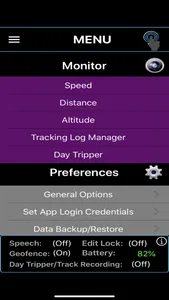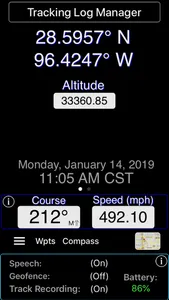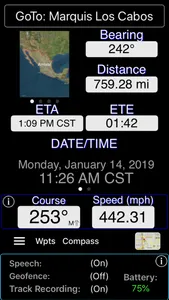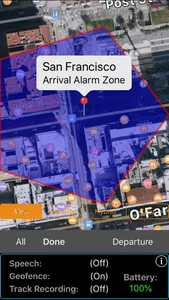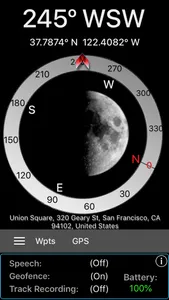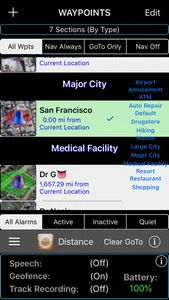NaviTracker has all the features that any person involved with outdoor recreational or navigational activities would need. The app operates on any iOS device (in background or foreground) that has a built-in or Bluetooth-connected GPS receiver. Navigation is based on GoTo Waypoints "As The Crow Flies". No Internet connection is required (can be used in Airplane Mode). However, when a Internet connection is present, location information is displayed on a map and Waypoints can be selectively interfaced with Apple’s Map app when installed on the same device.
Map displays are available when in off-line mode, provided that map images were downloaded from Open Street Maps (OSM) for each Waypoint prior to navigational use. Off-line maps are stored locally on the device and are managed by the user.
A comprehensive set of Navigation Screens are available to display Compass and typical GPS data.
A rich database of Waypoints can be created from different input sources as well as user-supplied informational meta data.
Geofences to alert waypoint arrivals/departures can be configured as either circular or polygon-shaped Alarm Zones.
The user has the option to configure Alarm Notifications for monitoring targeted speed, altitude, and/or distance sentinels.
Alarm notifications can also be in audible voice format (English language) in case the device is being used while driving (when notifications are usually muted by iOS to prevent distraction).
A Tracking Log Manager handles a catalog of user-named track history for future review and analysis. Named tracks can be shared via email in formats ready for import into Google Earth, OSM, or into the NaviTracker app installed on a different iOS device.
Some of the utility features cover data backup via File Sharing, email attachment, or synchronization with nearby devices running a copy of NaviTracker.
Tracking history files can also be imported directly into the app as email attachments received on the device.
Devices with iOS 12 (and later) can configure the app to use Siri for short-cut commands.
The app performs all navigation functions without being connected to the Internet.
NOTE: With the exception of Siri Voice Shortcuts and selected downloading of Map images for off-line navigation, the app does not upload or depend on being connected to the Internet in order to perform core navigation functionality. All user-data is securely stored locally on the device and access-protected with owner configured password and/or a biometric type authentication method (e.g. Touch ID, Face ID).
Although primarily targeted for iPhone devices, the app can also be installed on an iPad or iPod touch, running iOS 11.0 (and later) as long as a GPS receiver hardware is accessible for location tracking. The GPS receiver can either be an integral part of the mobile device or a third-party unit connected via Bluetooth.
Map displays are available when in off-line mode, provided that map images were downloaded from Open Street Maps (OSM) for each Waypoint prior to navigational use. Off-line maps are stored locally on the device and are managed by the user.
A comprehensive set of Navigation Screens are available to display Compass and typical GPS data.
A rich database of Waypoints can be created from different input sources as well as user-supplied informational meta data.
Geofences to alert waypoint arrivals/departures can be configured as either circular or polygon-shaped Alarm Zones.
The user has the option to configure Alarm Notifications for monitoring targeted speed, altitude, and/or distance sentinels.
Alarm notifications can also be in audible voice format (English language) in case the device is being used while driving (when notifications are usually muted by iOS to prevent distraction).
A Tracking Log Manager handles a catalog of user-named track history for future review and analysis. Named tracks can be shared via email in formats ready for import into Google Earth, OSM, or into the NaviTracker app installed on a different iOS device.
Some of the utility features cover data backup via File Sharing, email attachment, or synchronization with nearby devices running a copy of NaviTracker.
Tracking history files can also be imported directly into the app as email attachments received on the device.
Devices with iOS 12 (and later) can configure the app to use Siri for short-cut commands.
The app performs all navigation functions without being connected to the Internet.
NOTE: With the exception of Siri Voice Shortcuts and selected downloading of Map images for off-line navigation, the app does not upload or depend on being connected to the Internet in order to perform core navigation functionality. All user-data is securely stored locally on the device and access-protected with owner configured password and/or a biometric type authentication method (e.g. Touch ID, Face ID).
Although primarily targeted for iPhone devices, the app can also be installed on an iPad or iPod touch, running iOS 11.0 (and later) as long as a GPS receiver hardware is accessible for location tracking. The GPS receiver can either be an integral part of the mobile device or a third-party unit connected via Bluetooth.
Show More


